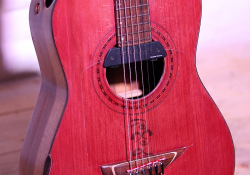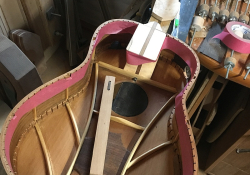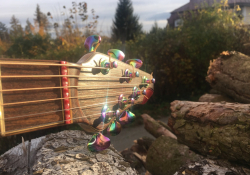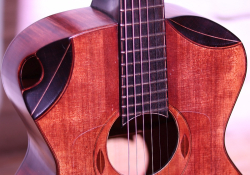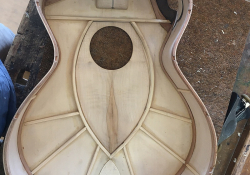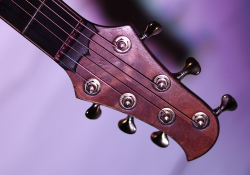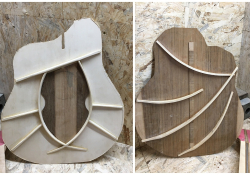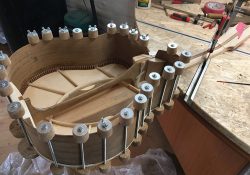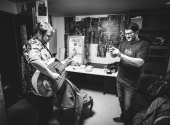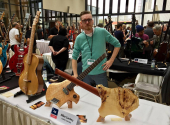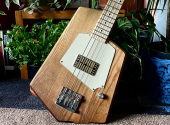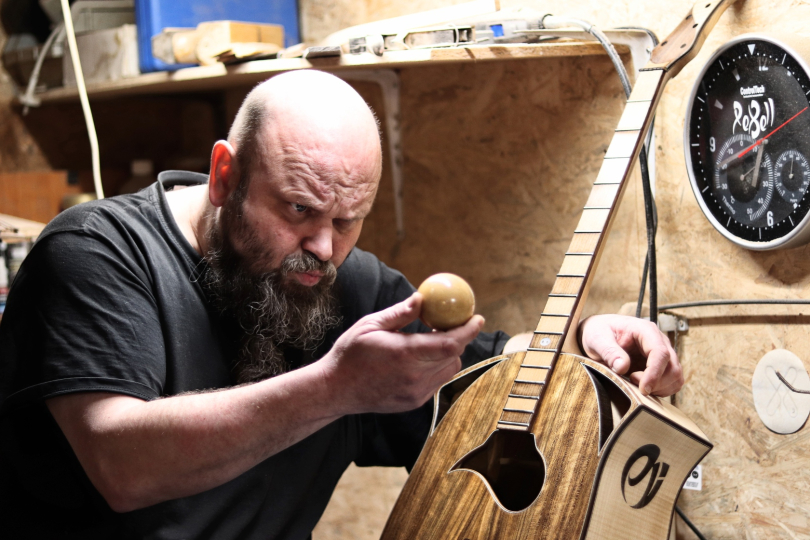
Dreamstruments #11: ReBell Guitars
There are guitar makers for whom the conservative Pre-war "Saint" Martin is not untouchable. They're not afraid to set out on adventurous journeys towards exciting new experiences. They don't let convention hinder them and make real (wild) dreamstruments. One of them is Petr Taks (ReBell guitars).
After thirty years of being an active musician, Petr started thinking about how to acquire new instruments. Whether to continue earning in the corporate environment to be able to buy them or try something completely different. Finally, he decided to start a totally new stage of his life and enrolled at the Vocational School of Violin Making in Cheb with a bold plan to make his own guitars.
Acoustic guitar: a space for innovation
At his mature age, he already knew what he wanted, so he became an enthusiastic student who desired to discover brand-new, fresh things in this (perhaps paradoxically for some) very progressive field. Unlike the violin, whose future makers learn in school that the technological development of the instrument has been, in fact, completed (there are no ground-breaking innovations either), the guitar is far from that stage. This is not only thanks to technological developments but also to new music styles and techniques.
So the acoustic guitar has been going through a very turbulent evolution over the last thirty or forty years, with a vast number of great, innovative, beautiful and previously unseen models being created. However, many of these innovations are not brand-new and have often been rather half-forgotten due to external circumstances (such as the so-called Tornavoz).
There is still plenty of room for innovation, and it's great that today everyone can choose according to their liking, style, ability, taste and wallet. There is no need to set off passionate debates because the invisible hand of the market will judge all this fairly. Ultimately, only the genuinely functional ideas will come through, and legendary vintage guitars can exist side by side with eccentric novelties. Let's take a closer look at some of these from ReBell guitars.
ReBell PerSona
As an active player, Mr. ReBell was looking for the right stage guitar for him: to be small, compact, ergonomic, comfortable, with a convincing stage sound. And with enough sonic delicacies suitable for his typical fingerstyle. Going through several intermediate stages, this red parlor gradually crystallized.
A funny detail is that this guitar was originally made for a particular customer who eventually stopped calling. When its sound potential became fully apparent, Petr never let it out of his hands, and today it is his main gig instrument. The sample clearly shows that a stage guitar is not supposed to be extra resonant and impressive when played unplugged. Its main strength is in an amplified, natural sound, ideally without feedback.
The PerSona is a small guitar and actually sounds quite tinny when unplugged. However, its charm fully develops thanks to a fine-tuned sound system with two pickups (Schatten Pickups HFN and Seymour Duncan Mag Mic), whose signal is sent to two special LR Baggs Session DI boxes connected to a high-end Schertler JAM 100 acoustic combo. Combining a humbucker (Mag) and an internal microphone (Mic, whose role is taken over by the HFN for feedback on larger stages) ensures a truly impressive sound from such a small guitar.
I've heard it live a few times, and sound engineers and listeners alike have always marvelled at its excellent sound. So, in this case, the mission was definitely a success. Red stained cedar complemented by ovangkol, wide and in two directions sloping sides for a more comfortable position (Manzer Wedge), armrest, soundport and, as a visual highlight, the tuning pegs in an iridescent shade of "golden chameleon". This is a really strong PerSona-lity.
ReBell Maya
The second ReBell series offers grand concert or mini jumbo shapes, at first sight, more conventional in appearance, but again with many unusual details. However, the essential one is not visible because it is inside the guitar. In fact, Mr. ReBell deliberately avoids the standard X bracing (which actually started the guitar revolution more than a hundred and seventy years ago). He says with a straight face that no cross is allowed in his guitar, adding that, after all, plenty of other guitar makers offer it as standard.
Each of his guitars has its specific bracing, which is a little more complicated than the classical cross, but ultimately a little more beneficial to the sound. Of course, this is a strong statement opposing more or less the entire industry, so instead of talking, let its actions speak for the guitar.
A school project with an American Indian concept, in the colour of blood soaked into the ground, with a head in the shape of an eagle's beak, complete with exclusive inlaid details and a rosette evoking a dream catcher. The whole instrument has an aged patina finish (where new looks like old).
The soundboard is made of top-quality Alpine spruce complemented by maple, of course, there are special braces made of resonant spruce, rosewood fretboard and bridge, saddle and a nut made of stained bone and colour-tuned "golden" frets. The armrest and soundport are intricately inlaid in wenge, in a style faithfully mimicking the texture of feathers. Simply an Indian guitar with a thickly earthy and dynamically detailed sound.
It was planned as a strictly studio instrument without plugging, subtle and fragile to capture the finest nuances of finger technique. It is, therefore, not suitable for harsh chordal strumming. Still, the delicate approach will be amply repaid to the player with a fantastically responsive colourful sound, even including somewhat shocking bass from the relatively small body. A comfortable inspirational guitar with a strong visually portrayed story.
ReBell Efí
The last product group is the sponsor instruments, where the customer just brings a basic assignment but otherwise gives the guitar maker a free hand to create a dreamstrument. It is, therefore, a completely free discipline allowing for a very non-conventional approach (i.e. a bell-shaped guitar). In Efí's case, a guitar for a home studio with an enhanced bass component was created to celebrate the anniversary of a jazz bassist and amateur mathematician with his favourite number 7.
The magical seven can be found in this model in a plethora of references: from the dimensions, lengths, ratios always in multiples of seven, through the seven types of woods used, the unique bracing of the top board made of seven parts, the bracing of the back symbolizing VII or the Roman seven and, of course, the twenty-one frets, the visual representation, the internal carvings and the name Efí. The E is indicated by the shape of the bridge, and the Φ(phi, in Czech "fí") on the soundhole is the twenty-first letter of the Greek alphabet.
The model also has fanned frets with a breakpoint (straight fret) on the seventh fret, open Sperzel locking pegs and, with an acoustic guitar, a very unusual neck-through-body to support deep tones (long waves). There is a Fishman Rare Earth pickup (magnet with microphone) to enable stage sound. The neck and its connection to the bulky asymmetrical body are tuned to the very hand of the satisfied customer. And the finishing touch: an ornament inlaid with gold leaf. This is what a custom guitar can look like when you give free rein to the wild ReBell.
Petr Taks also offers guitar-building experience, where you can build a guitar yourself under his guidance. As a former marketing officer, he remembers well the strong personal connection when making something yourself. He even has a hard time parting with some pieces. Still, at his gigs, he would be shouting from the rooftops: “Let there be more and more guitars in the world!” To play as many songs as possible. He's a true ReBell.
If you have found an error or typo in the article, please let us know by e-mail info@insounder.org.

